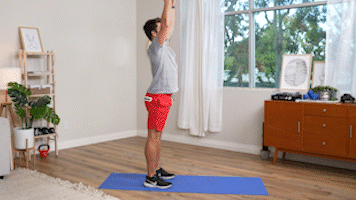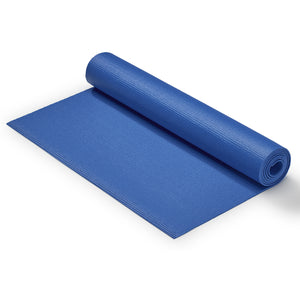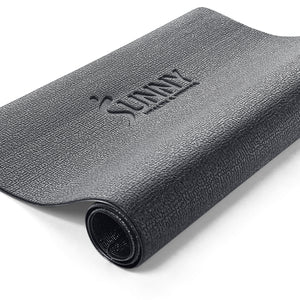What is Yoga?
This was a question that I had asked myself when I was invited to my first-ever yoga class. I'll never forget it; it was 2008 and my sophomore year at Arizona State where I was competing on the Intercollegiate team.
A teammate of mine and myself were asked by two members of the women's gymnastics team if we wanted to join them in a yoga class. At first, we were both a little hesitant since neither of us really knew anything about yoga and what all exactly even went on during a yoga class.
The gymnast then revealed that there would be two members of the University's wrestling team that would also be meeting them there for the class. Once we heard that, we both changed our minds in a second.
It didn't help that he and I were trying to "impress" each of the gymnasts at all costs! So, if they said "jump" we would've asked, "how high?" We would've dragged ourselves to just about anything if they asked!
Walking into the studio, the faint sound of tranquil music and the strong aroma of incense was already putting me in a trance-like state. After placing down the yoga mats, we asked the gymnast, "What would we be doing during this yoga class?" They answered back "the class is called Bikram" which at the time was a meaningless word.
My teammate and I looked at each other and nodded as I condescendingly said under my breath, "how hard could it possibly be!" Little did I know that this was the calm before the storm and my views on yoga were about to drastically change.
For those of you that aren't familiar with Bikram yoga, it's a vigorous form of yoga performed in a heated humidified studio and is also known as hot yoga. How hot you ask… 105 degrees hot!
As you can imagine, my teammate and I had to step out of the hot box quite a few times, throughout the class to catch our breath. By the end of the class, it seemed like I had lost at least 5lbs of water weight and was floating in a pond of sweat. Even though I had to step out from class on a few separate occasions and had a difficult time walking back to the car.
The moment I sat down; I had this amazing natural euphoric feeling running through my blood and every single inch of my body. It felt as if I had just finished a very challenging 2-hour swim workout. It was a feeling that I had only felt after finishing difficult swim practices.
With that being said, I don't recommend your first-ever yoga class being a Bikram or a heated one. So, before we get into some of the beginner yoga poses and stretches, I think it's important to briefly explain what yoga is and what the common goal should be while practicing yoga. Then, hopefully, you won't make the same mistake that my teammate and I made, of doing something that you know absolutely nothing about.
What Actually is Yoga?
The word "Yoga" derives from the Sanskrit root "Yui", which can be translated 'as to bind or yoke together' or 'a 'Union' between mind, body, and spirit (1). The physical helps the mental and vice versa; therefore, one cannot exist without the other (2).
When yoga originated in India, it was known as 'the science of quieting your mind'. Yoga is a complex system of spiritual, moral, and physical practices, aimed at attaining self-awareness (1). It usually consists of physical exercise, breathing techniques, and meditation or relaxation.
Different forms of yoga exist throughout the world today. In the West, the most widely practiced form of yoga is called "Hatha Yoga". This form includes physical postures and exercises to stretch and improve the flexibility of the body, breathing exercises, relaxation, and meditation (1).
Benefits of Yoga
Today, yoga is used by people suffering from a range of health-related problems as well as to improve general fitness levels and health (1).
There are many reasons why one might start practicing yoga. Typically, the common reasons are to help relieve stress, anxiety, depression, and chronic pain.
It is widely promoted as beneficial to physical, psychological, and spiritual health. You can also find it being used as part of programs such as mindfulness-based stress reduction used for cancer patients (1).
What is the Main Goal of Yoga?
When looking at the big picture, there is a lot more to yoga than just moving the body. The goal of any yoga practice is to attain "Moksha" - meaning 'liberation or freedom' (3).
Patanjali was a sage in India who is believed to have authored several Sanskrit works, the most prominent of which is the "Yoga Sutras" a classical yoga text dating to 200 BCE- 200 CE (3).
According to Patanjalis, "Yoga Sutras" there is an eight-fold path leading to liberation, known as the "Ashtanga Yoga System" or "Eight Limbs of Yoga" (Ashta-eight/Anga-limb) (3).
These are the 8 main points of focus one should have, during their yoga practice. According to Cory Martin, "To be able to comprehend yoga, we need to understand all eight of these principles (2).
- Yamas: Self-Control
- Niyamas: Methods of Discipline
- Asanas: Physical Postures
- Pranayama: Breath Works
- Pratyahara: Assistance Withdrawing from the Senses
- Dharana: Concentration
- Dhyana: Meditation
- Samadhi: Absorption or Liberation from the Mind and Body
8 Beginner Yoga Poses
Below, I've included 8 beginner yoga poses, that are a great place to start if you've been either thinking about starting yoga or just starting to get into your practice.
Each of these 8 poses is beneficial in different ways and can be done anywhere. All you need is a little bit of space.
Forward Fold

You have probably done this pose before even if you haven't practiced yoga. It's one of the first poses you will learn when starting a yoga journey but is typically the most misunderstood.
This pose is an extension of the entire back body, including the soles of the feet and up the back of the legs. When you bend, you are stretching the entire sheath of muscle and connective tissue, from the fulcrum of the forward bend to the pelvis (4).
Forward fold calms the brain and helps relieve stress. It also helps stimulate the liver and kidneys, along with stretching the hamstrings, calves, and hips (4).
How To Forward Fold:
Begin in Mountain pose. Then, slightly bend the knees and fold your torso by hinging from the hips and not the lower back. Your hands may land onto or next to your feet.
Forward Fold Tips:
When performing forward fold, make sure you're lengthening your spine and not rounding. Also, make sure that you're lengthening your neck, extending the crown of your head toward the ground as your shoulders draw down your back and towards your hips.
To feel even more of a stretch, grab each elbow with the opposite hand and let gravity pull your weight and head down towards your mat.
Mountain Pose

Mountain pose enhances stability and helps promote self-esteem and inner strength. This full body stretch tests your focus and concentration (4).
Physically, it improves your posture, strengthens your thighs, knees, ankles, and it also firms your abdomen and buttocks, relieves sciatica, and reduces flat feet.
It is considered the baseline for many of the standing poses in yoga, so learning the correct posture is essential (4).
How To Mountain Pose:
Stand upright with feet facing parallel to each other and big toes touching. Your hips, knees, and ankles should stack evenly over one another. Raise your arms overhead, with shoulders open and down, away from your ears. Rotate your pinky finger in towards each other. Balance here.
Mountain Pose Tips:
While performing Mountain Pose focus on relaxing your shoulders and keeping shoulder blades down, out, and away from your ears. Lift the sternum, without pushing lower ribs forward.
Make sure that you're staying rooted through all sides of your feet, as you touch the big toes together while keeping your heels slightly apart. Once grounded, elongate from the pelvis through the top of your head.
Cat-Cow

In most yoga classes, the Cat pose and its counter pose Cow pose are paired together because these poses help to warm up the spine and are a great precursor for forwarding bends while being expansive counterpose to inversions and backbends (4).
Benefits of Cat pose include warming up the spine, shoulders, and hips. It also improves posture and counteracts the effects of sitting and computer work.
Benefits for the counterpose - Cow pose - include, warming up the spine, shoulders, and hips to prepare for rigorous yoga asana practice. It can be calming, relaxing, and help you manage stress (4).
How To Cat-Cow:
To start Cat-Cow, begin in tabletop with your hips directly over your knees, and your hands shoulder directly below shoulders. Begin with Cat pose, making sure your shoulders are over your hands and wrists and that you suck the belly button in, as you round your back and tuck your tailbone in underneath you. Return to tabletop and press through to Cow pose. Your shoulders should still be stacked over your hands and wrist. Focus on pulling the shoulders back, as you arch your back, pushing the belly button to the floor and lifting the chin and sternum. Alternate between Cat and Cow poses at a pace that feels good to you.
Tree Pose

Tree pose is a standing pose that helps improve balance, and helps strengthen your legs, glutes, core, and back. It can also help improve your posture and alignment while helping calm down and relax the mind by relieving anxious thoughts and feelings (4).
How To Tree Pose:
Firmly root your right foot into the ground, straighten your right leg (but don't lock out the knee). Reach your arms overhead nice and tall like the branches of a mighty tree. You may also choose to bring your hands to the "heart center" also known as "prayer hands". Place the sole of your left foot on the inner part of your right shin. Repeat on the other side.
Tree Pose Tips:
In Tree Pose, focus on always engaging your legs, glutes, core, and back. Make sure you're pressing your foot into your shin, your pelvis is level and squared to the front, and your gaze straight ahead. If needed, place feet/toes on the floor for better stability.
Do not get discouraged if you have a difficult time lifting your foot off the ground and balancing at all, this pose takes practice and patience. If you want more of a challenge, bring the sole of your foot to your thigh instead.
Easy Pose

Easy pose is the preferred meditation posture that's been used by yogis for centuries. It helps improve postural awareness, can help manage stress, and creates a foundation for meditation practice (4).
This pose improves your nervous system by activating your body's relaxation response and deactivating its stress response. It also helps regulate and lower blood pressure. Easy pose also strengthens your core and stretches your groin and inner thighs (4).
How To Easy Pose:
To get into this pose, cross your legs "crisscross applesauce" like when you were a kid. Rest your palms facing up on top of your knees, bring the tip of your index fingers and thumbs together.
Easy Pose Tips:
When in Easy Pose make sure the arches of your feet are touching opposite shins, while keeping your pelvis in a neutral position and your back straight with your chest up.
Palms can stay facing up while resting on knees or they can be palm down on top of your knees. Many people choose to have their palms up, while their index finger touches the tip of their thumb but do what feels most comfortable to you.
Continue to take deep breaths and relax!
Downward-Facing Dog

Downward dog is one of the most widely recognized poses and a posture that you will likely perform countless times throughout your yoga practice.
It strengthens the core and improves circulation while providing a delicious, full body stretch. The downward dog also helps to build better balance and flexibility throughout your whole body (4).
Some other benefits of the downward-facing dog are that it helps tone the arms and legs. It also opens and strengthens the shoulders, lengthens the hamstrings, stretches the calves, and prepares the body for heating.
How To Downward-Facing Dog:
From the tabletop press, your palms into the mat then exhale and lift your knees off the floor. Keep a slight bend in the knees and lift your heels off the floor. Make sure your head is between your upper arms. On your next exhale, push your thighs back and stretch your heels to the floor. Lengthen your tailbone away from your pelvis and lift your tailbone to the ceiling. Straighten your legs, but do not lock out your knees. Widen your shoulder blades and draw them down towards your tailbone. Hold here (4).
Downward-Facing Dog Tips:
To get more of a stretch through your hamstrings and calf, lift slightly up onto the balls of your feet, then pull your heels a half-inch or so away from the floor. You can do this simultaneously with both heels and do one side at a time.
Single-Legged King Pigeon Pose

Pigeon pose is extremely effective and helps open both the external and outward rotation of the femur bone in the hip socket. Opening your hips improves circulation to your lower extremities and helps when performing seated postures and everyday movements (4).
This pose stretches your thighs, inner hips, and buttocks in different ways in both your bent and straight leg. Be sure to approach this pose thoughtfully and consciously.
How To Pigeon Pose:
Raise your left foot off the ground, in line with your hip. Slide your left knee forward, angling your left shin under your torso so that your left foot is at the front of your right knee and the outside of your left shin is resting on the floor. Then slide your right leg back and straighten out your knee resting the top of your foot on the floor. Place hands in front of your left shin for support and to help keep your torso upright. Hold, and when you're ready repeat on the other side (4).
For more of a stretch, lower your chest down towards the floor. This would be called 'Sleeping Pigeon'.
To modify the pigeon pose, bend your right leg, keeping your foot flat on the ground. Place your left ankle on top of your right knee. Then press your left knee towards the ground, to feel more of a stretch.
Pigeon Pose Tips:
When performing the pigeon pose, make sure that you're lifting your torso away from your thigh. Keep your back leg straight, resting your thigh and top of your foot on the mat. Keep your hips parallel and aligned with each other.
Child's Pose

The child's pose centers on creating a moment of rest and creates a breathing space to break when needed. This position focuses on stretching the body while relieving stress and fatigue.
More specific benefits for a child's pose include stretching the hips, thighs, spine, and shoulders. It also helps stimulate digestion, relieves stress, anxiety, and fatigue, and calms the mind (4).
How To Child's Pose:
Sit on folded knees, resting thighs on your calves. Touch the big toes together and spread knees out wide. Rest your forehead gently down on the mat, while extending your arms long and inching your fingers up towards the top of the mat. Hold here for as long as feels good to you.
Child's Pose Tips:
If you would like to get more out of this pose, you can place your arms behind you or you can gently lean from side to side to get more of a stretch on a particular side.
Closing Thoughts
After feeling like I was going to experience a heat stroke in my first ever yoga class in 2008, I took a 5-year hiatus before taking my next yoga class in 2013. If it wasn't for my then-girlfriend, who knows if I ever would've given it another chance.
As the months passed, I started realizing that I had been attending a yoga class every weekend for the past 6 months with my girlfriend as she worked on getting her 200-hour Yoga Teacher Training Certification.
I was able to finally experience firsthand the mental and spiritual clarity that yoga had brought to so many people, along with the lifestyle and community it provided. Little did I know that 4 years later, I would start my journey to getting my 200-hour Yoga Teacher Training Certification.
If you told me in 2008 after almost passing out and having a heat stroke that I would be a Certified Yoga Instructor in just a few years, I would've thought you were crazy. But there's only one reason why something that has been around for centuries, is still around today… because it works!
(1) Karen Pilkington and the CAM Cancer Consortium, Yoga, 2019. https://cam-cancer.org/en/yoga Accessed 3 February, 2020.
(2) Cory Martin, Yoga for Beginner: Simple Yoga Poses to Calm Your Mind & Strengthen Your Body. 2015
(3) Syama Allard, Who Was the Patanjali and What are the Yoga Sutras? 2020. hinduamerican.org/blog/who-was-patanjali-and-what-are-the-yoga-sutras. Accessed 3 February, 2020.
(4) Poses by Anatomy, Yoga Journal. www.yogajournal.com/poses/anatomy. Accessed 3 February, 2020.

























Add Your Name & Email
Please enter your name and email to continue.We won’t display your email publicly.